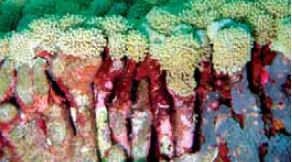What are corals/types of coral?
Corals are two-layered invertebrates
that live in groups (i.e. they are colonial) and are related to jellyfish and sea anemones.
Corals are made up of tiny individuals
called polyps. Each polyp is like a fl uid-fi lled bag
with a ring of tentacles surrounding
its mouth, and looks like a tiny anemone. Polyps within a colony are linked by living tissues
and can share their food (Allen & Steene, 1994). In
some corals, the polyp extracts calcium
carbonate from the sea and secretes it as a cup of calcium carbonate from the bottom
half of its body. These cups provide anchorage
for the polyps but when threatened, the
polyp can retreat into the safety of the hard cup. When the calcium carbonate cups of many
billions of these polyps fuse together, they
form coral reefs (Veron, 2000).
There
are two main types of corals (1) Stony Corals and (2) Soft
Corals.
(1)Stony (Hard) Corals:
Some stony corals obtain their food
from one-celled organisms called zooxanthellae.
Zooxanthellae are single-celled
organisms that use sunlight for photosynthesis and transfer 95% of the food they
produce to coral polyps. Both coral and the zooxanthellae benefit from this
association. The zooxanthellae receive protection from currents and herbivores, as well
as some nutrients from waste produced by coral polyps. This kind of association
- where two different kinds of organisms benefi t from each other - is called a mutualistic
association. These corals are called hermatypic corals. Individuals polyps of
hermatypic corals secrete calcium carbonate (limestone) skeletons which, in time
form coral reefs. Therefore, hermatypic corals
are also known as reef building corals.
Because of this association with
zooxanthellae that need sunlight to produce food, hermatypic corals are dependent on
sunlight and only grow in clear shallow waters less
than 60m deep, which have a temperature
range between 25° and 30°C.
Hermatypic corals prefer narrow salinity and low
turbidity ranges. Therefore, hermatypic corals need
(a) a particular range of temperature;
(b) sunlight;
(c) generally clear water (low
turbidity); and
(d) a narrow range of salinity (Allen
& Steene, 1994).
There are about 845 species of reef-building corals (Global
Marine Species
Assessment, 2008).
There also are some stony corals which
do not have zooxanthellae and do not build reefs.
These are called ahermatypic corals
and can live in both shallow and deep water (some up
to
6,000m deep).
Stony corals have different shapes and
forms. Some selected shapes are shown on these
facing pages.
 |
| Foliaceous (forming a whorl) |
 |
| Massive |
 |
| Tabular |
 |
| Branching |
 |
| Columnar |
 |
| Digitate (like fingers) |
 |
| Encrusting |
 |
| Mushroom |
(2) Soft corals:
Soft corals lack a calcium carbonate
skeleton, hence their common name. However, in their bodies are tiny hardened calcium
particles called spicules that provide support.
Some selected soft corals are shown
below.
 |
| Black or Thorny corals |
 |
| Fire and Lace Corals |
 |
| Sea fans |
 |
| Sea whips |















0 comments:
Post a Comment